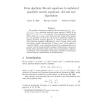Free Online Productivity Tools
i2Speak
i2Symbol
i2OCR
iTex2Img
iWeb2Print
iWeb2Shot
i2Type
iPdf2Split
iPdf2Merge
i2Bopomofo
i2Arabic
i2Style
i2Image
i2PDF
iLatex2Rtf
Sci2ools
DAGSTUHL
2007
2007
From Algebraic Riccati equations to unilateral quadratic matrix equations: old and new algorithms
The problem of reducing an algebraic Riccati equation XCX − AX − XD + B = 0 to a unilateral quadratic matrix equation (UQME) of the kind PX2 + QX + R = 0 is analyzed. New reductions are introduced which enable one to prove some theoretical and computational properties. In particular we show that the structure preserving doubling algorithm of B.D.O. Anderson [Internat. J. Control, 1978] is in fact the cyclic reduction algorithm of Hockney [J. Assoc. Comput. Mach., 1965] and Buzbee, Golub, Nielson [SIAM J. Numer. Anal., 1970], applied to a suitable UQME. A new algorithm obtained by complementing our reductions with the shrink-and-shift technique of Ramaswami is presented. Finally, faster algorithms which require some non-singularity conditions, are designed. The non-singularity restriction is relaxed by introducing a suitable similarity transformation of the Hamiltonian.
Algebraic Riccati Equation | Algorithms | DAGSTUHL 2007 | Quadratic Matrix Equation | Software Engineering |
| Added | 29 Oct 2010 |
| Updated | 29 Oct 2010 |
| Type | Conference |
| Year | 2007 |
| Where | DAGSTUHL |
| Authors | Dario Andrea Bini, Beatrice Meini, Federico Poloni |
Comments (0)

